
The Book
Temporal Anomalies in Time Travel Movies
presents
Temporal Anomalies Index 2013
As explained previously in Temporal Anomalies Classics, the useful and oft-linked index to the years of Examiner articles was lost; although it has been restored, the process of reproducing those articles for backup then seemed advisable. This was the fifth of a series of indexing articles, each expected to cover articles in series begun during a particular calendar year: 2009, 2010, 2011, and 2012 already posted. 2013 began with Meet the Robinsons, then Men in Black III, Looper, and H. G. Wells' The Time Machine, something of a divergence from films into Temporal Theory 102, then The Jacket, Butterfly Effect 3: Revelations, and Safety Not Guaranteed.
As explained, this series of indices was started when it became temporarily impossible to maintain this web site and seemed advisable to provide links to early Examiner articles for ease of access. That in turn became problematic, and we have since determined instead to move all that material here to M. J. Young Net, and hopefully to support it by reader contributions through Patreon and other means.
Miscellany
This year again included several articles which were not time travel analyses but related to time travel movies in other ways, including:
Meet the Robinsons
Disney's Pixar productions are always well-made and usually entertaining, but how do they do with time travel? Disney's The Kid was too much fantasy and not very well structured for analysis, but as we look at the new one, Meet the Robinsons, we find a lot of challenging ideas in an entertaining format. The final verdict is--well, first, the details:
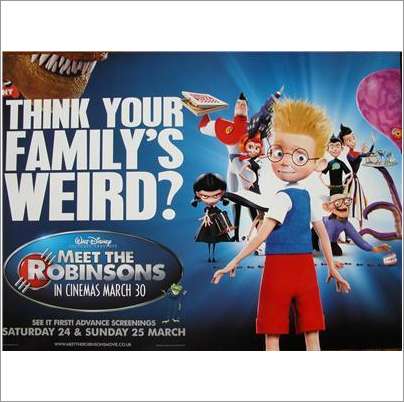
- Outline: provides the storyline and initial framework, showing some of the problems up front.
-
Identities: goes deeper, showing how the characters in the past are connected to those in the future, and thus introducing some of the film's most serious problems.
-
Starters: attempts to construct the original history unaltered by any time travelers.
-
Fran: hits the complication of Lewis' future wife, who is on the cusp of vanishing from his life but for his knowledge of the future.
-
Mom: recognizes the problem created when Lewis successfully obtains the image of the face of his birth mother at the science fair (because he has not been sabotaged), and so is compelled to find her.
-
Goob: tries to resolve the disasters which occur when Goob attempts to destroy Lewis' future by stealing the time machine.
-
Pursuit: explains why and how Wilbur will make his trip to the past, and examines some of the problems of tracking someone backwards in time.
-
Back: takes Lewis to the future, with devastating consequences.
-
Quirks: looks at a few minor temporal issues in which changes in the future are significant to the past.
-
Waves: crashes into one of the least logical concepts in time travel, that of the future changing slowly in response to a change in history, and finds it is even less rational in this version.
-
Poof: is completely mystified by the abrupt unmaking of Doris.
-
Baby: covers the last couple of trips through time, but again hits a problem.
-
Significance: doubles back to discuss an implication that is a common error in time travel stories, and why even insignificant people are significant.
The film is laced with disasters that are overlooked in the name of a fun story. It certainly is enjoyable, but don't expect it to make any sense at any point, at least from a time travel perspective.
Men in Black III
From the moment the movie was announced it created a stir: what kind of nonsense would the Men in Black franchise promote with a time travel movie? We announced it months in advance in Men in Black III remakes history, and again hours before it opened with Men in Black III May 25th U. S. debut midnight shows tonight, and then we managed to attend the film. Here are the articles on that:
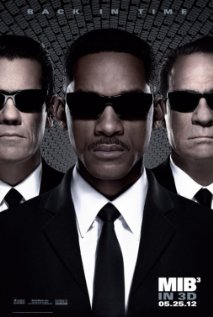
With the video release we now present a more complete analysis:
-
Original History: gives us the brief history of the world, including significant points in the first two movies, before any time travel occurs.
-
Boris: constructs the events which must have occurred when Boris makes his trip to 1969 and kills K, working up to the present in 2012.
-
Extinction: tries to unravel how the Boglodites can be extinct before 2012 if the Arc Net is what killed them, but only arrive at the planet in 2012 if it is not implemented.
-
Deathtoll: tries to make sense of Griffin the Arcanan's suggestion that "where there is death there will always be death" in connection with the moments in the film to which he was not applying it.
-
Quibbles: picks up the little questions, the genetic issue, the absence of a murder from the report, and the nature of the time travel itself.
-
Memory: attempts to find an explanation for why J remembers the history that never happened, and no one else does.
-
Futures: begins exploring Griffin's odd ability, based on statements he makes about possible futures.
-
Disconnects: continues exploring Griffin's abilities, seeking some explanation for why chocolate milk affects villain entrances or tips are connected to meteorite collisions.
-
J: covers the main outline of the history J creates by his leap to 1969.
-
Boglodites: returns to the question of how and when these aliens became extinct, determining that it must have happened in different ways in different histories.
-
Loops: looks at the most obvious predestination paradox and presents an explanation for it.
-
Inconsistency: considers the last anomaly, the one minute leap at Canaveral, looking for why it is different, and how it might work, and wrapping up the analysis of the film.
In conclusion, well, we didn't expect it to work, and we already observed that it doesn't, but it has given us a lot more unworkable nonsense for our dollar and proves to be a fun film. Kudos particularly to Brolin's portrayal of the young K.
Looper
Bruce Willis appears in his third time travel movie, in this one playing an assassin whose career is slated to end with his older self, Willis, being killed by his younger self, Joseph Gordon-Levitt. The action starts when he chooses not to let that happen, but the time travel gives us many interesting questions and problems.
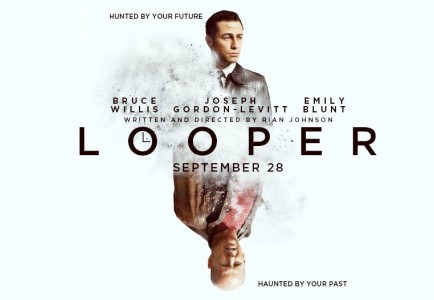
-
Kudos: briefly introduces the film, noting a few actors who like star Bruce Willis have done multiple time travel movies, presenting the premise, and providing approximate dates for the setting.
-
Premise: explores the original history, then finds trouble in the basic concept, in that each trip to the past has to create a new history before there can be a next one.
-
Messages: faults the concept of sending messages to the older version of a person by injuring the younger version.
-
Flashbacks: brings out the aspect of memories appearing as actions within the film, and considers the problem with Old Joe's memories.
-
Anomalous: attempts to reconstruct earlier versions of history, and finds the predestination paradox.
-
Destined: explores the predestination paradox at the heart of the story, and attempts to provide a solution.
-
Massacre: considers the problems surrounding Old Joe's attack on Abe's organization, particularly as it relates to what Abe ought already to know.
-
Retirement: finds a problem at the future end, involving how the retirement decisions are made.
-
Clockwork: explores the complications involved in identifying safe sites and times for the victims to arrive, and the greater complications created by trying to fix problems that inevitably will occur.
-
Notification: considers the problem of information traveling from the future as separate from the sending of victims, and seeks a way of preventing the problem of two anomalies for every victim.
-
Runners: answers why runners are dangerous.
-
Devastating: looks at the impact Old Joe has when he destroys Abe's operation, focusing on the problems which occur if the records are destroyed, and the problems which occur if they are not.
-
Inconsistent: shows how the treatment of different events within the film do not match.
-
Unchanged: catches the discrepancy that some changes to a looper reach him in the future instantly, and others never do.
-
Future: looks at the problem with the premise from the perspective of the information reaching the future.
Although it is an enjoyable and exciting film, it fails repeatedly as a time travel story.
H.G. Wells' The Time Machine

In 2002, the classic story The Time Machine was remade in a temporally disastrous version (analyzed previously). However, it had been made previously, in 1960 by George Pal, in a version a bit more faithful to the book. At issue is the degree to which this earlier film version stands as a time travel story. Thus here is our analysis.
-
Disambiguation: gives a brief background of the story as an introduction, including a few details of the journey itself.
-
Motivation: a problem in the remade version, this version also diverges from the book in presenting why the character (in this version, H. George Wells) makes the trip, although perhaps not so drastically.
-
Method: considers the problems involved in how the time machine appears to function, although it is a bit different in this case than in other films using the same type of machine.
-
Reverse: recognizes a more serious aspect to that means of travel if the time machine is moving through time backwards.
-
Mannequin: finds problems with the way the changing mannequin is presented in the movie.
-
Erosion: looks at complications which develop because of the suggestion that the time machine becomes trapped inside a cave created by a lava floe and has to wait for erosion to free it.
-
Evolution: crashes into the inconsistency that the isolated colony of morlocks have become inhuman but the isolated colony of eloi have remained quite the same.
-
Anomaly: addresses whether the film might be a fixed time story, and finds a reason to think otherwise.
-
Alterations: begins looking at what changes the time traveler might have caused with his return to his own time.
-
Genetics: considers the specific impact George will have on David Filby, who now knows the year of his death and might act differently because of this, which might in turn impact the future of the race in ways that are not significant to the race but highly so to the story.
-
Arbitrary: looks at the film's explanation of the division between morlocks and eloi, how and why it differs from the book, whether it is credible, and whether that is a problem for the story, as the series gives a final verdict.
The final verdict is that the story survives fairly well, if we accept its assumptions about evolution and war. This one is temporally plausible.
Temporal Theory 102
Confusion about time travel theory was still unresolved after our Temporal Theory 101 in 2009, with some readers challenging whether we could really know anything at all about what happens if you travel through time. Thus a second theory series, Temporal Theory 102, was created to address the issues in more detail and provide some of the answers hitherto oft-repeated in e-mail correspondence.
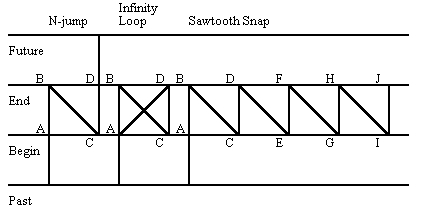
-
Knowing the unknown: introduces the series with a brief description of the major theories of time travel.
-
Nature of time: considers whether the future and the past exist, and uses the analogy of the book on the desk to illustrate how time is a dimension.
-
Mutability: considers whether history can be changed, and the ramifications of the fixed time theory belief that it cannot.
-
Parallel worlds: introduces discussion of parallel and divergent dimension theories, and the shared problem that you are not really in the past.
-
Unparalleled: shows the problem of a belief in identical parallel dimensions, in that a single trip to the past changes half of all such worlds to a different history.
-
Divergence: looks at a couple problems with divergent dimensions, including the creation of another universe from nothing, the absurd resolution of Schrödinger's Cat, and the duplication of the time traveler.
-
Change: introduces replacement theory and presents the issue of the causal chain.
-
Self-correction: discusses the idea that little things can be changed but big things cannot, and the problem with how the universe can know which are the little and which the big things.
-
Fixation: examines the popular interpretation of Niven's Law, to the effect that once history has been changed it remains so, and the problem that causes with a duplicate time traveler.
-
Freedom: examines the problems of randomness and free will in a theory in which history repeats and must repeat exactly the same to stabilize.
-
Rate of change: considers the issue of whether changes to history happen all at once or gradually, and at what rate they might do so.
-
Original history: explains and defends the concept of the first timeline, the one in which no time traveler arrives.
-
Stability: describes how to get an N-jump, the only desirable outcome of a time travel event, including how it can occur with a predestination paradox.
-
Repetition: explains the infinity loop, in which two histories each cause the other, with the examples of the grandfather paradox, making an intentional change to the past, and otherwise preventing your own actions, with mention of a method of changing the past without creating this problem.
-
Chains: looks at sawtooth snaps, the outcome when each version of history causes an entirely different one, with the examples of meeting yourself, taking an object to the past that has already been taken to the past, and the complication of the butterfly effect.
-
People: addresses the oft-asked question of what happens to everyone alive when their history abruptly ends.
-
Genetics: describes the genetic problem with several examples of how marriages, relationships, deaths, and other interventions can have unexpected major impacts on the future population of the world.
-
Summary: concludes the series with a review of how to analyze a time travel story.
It is unclear whether this is the entire series at this point; work continues on it.
The Jacket
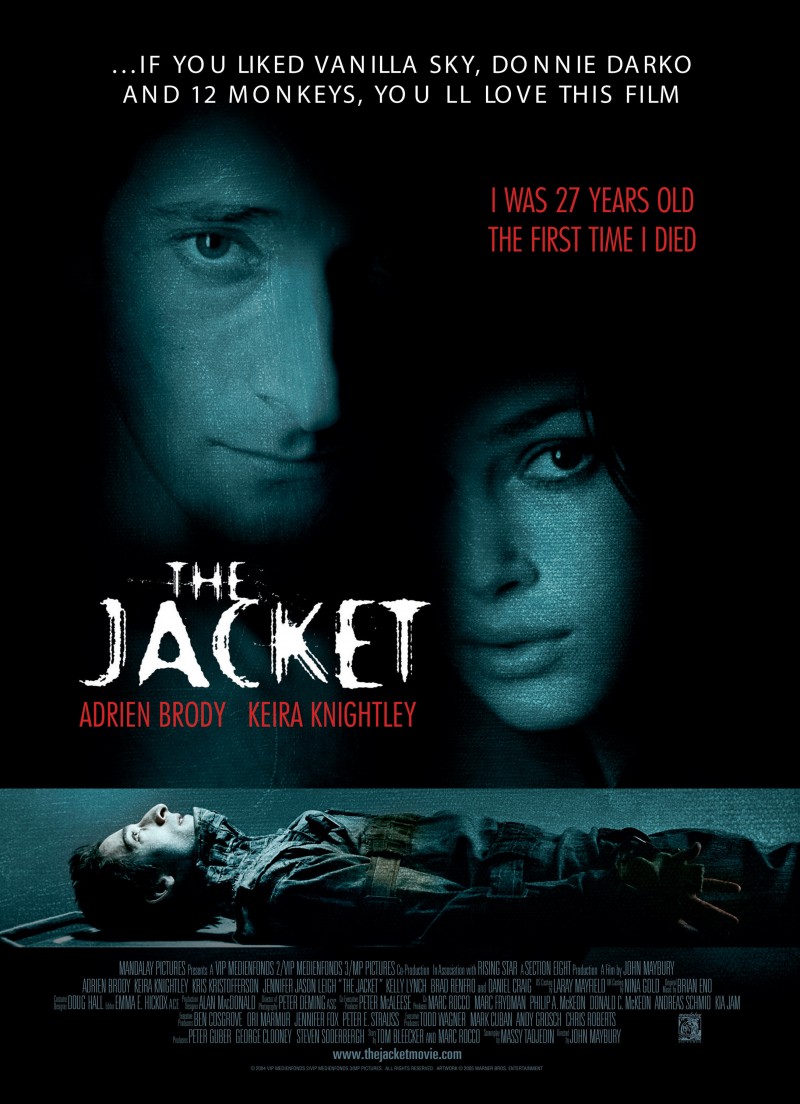
This film appeared on someone's list of the best time travel movies, so I bought a copy and put it on the list of films to watch. There was no clamor for it, which is to some degree surprising because it is an interesting and enjoyable film with quite a few convolutions to catch the attention. So the analysis was worth doing.
-
Introduction: manages to avoid spoilers while giving the setup for the story, introducing the problem that leads to the time travel events.
-
Method: explains how the time travel is accomplished, to the degree that this can be determined in this rather mysterious aspect of the film.
-
Fixed time: considers those parts of the story that a fixed time theory approach would resolve, and those which make fixed time impossible.
-
Dimensions: does the same for multiple dimension theory, allowing that some aspects could be resolved by it but others seemingly cannot.
-
Replacement: begins the analysis under replacement theory, with a starting point of what happens when Jack leaves his body in the past and travels to the future.
-
Becker: approaches the problem of Jack bringing names back to Doctor Becker that he only has because Becker remembers him bringing them to him.
-
Babak: tries to unravel the anomaly created when Jack tells Doctor Lorenson how to treat the patient he cannot know she is treating.
-
Absurdities: mentions those aspects of the film not related to time travel, mostly concerning law and medicine, which snapped our disbelief suspenders.
-
Death: addresses the problem of when and how Jack died, given that he made several trips to the future before hitting his head and thus must have left pasts in which he never recovered after exiting the drawer.
-
Letter: connects the head wound to the letter in a way that shows that Jack could not have discovered the injury in any history in which Jean did not receive and react to the letter he sent, and thus that most of what we see in the film could never have happened the way we see it.
It was an enjoyable film despite its problems, and well worth watching; but don't expect it to give any good lessons in how to craft a time travel story.
Butterfly Effect 3: Revelations
The promised analysis of the second sequel in the franchise has come to the top of the pile. Having found serious problems with The Butterfly Effect that were compounded and expanded in The Butterfly Effect 2, we held little hope for this installment, and thus were not disappointed.
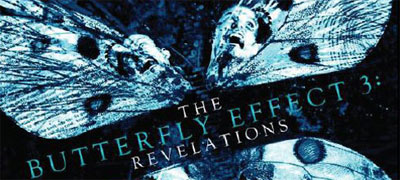
-
Background: gives a quick start on the franchise and the film, without spoilers.
-
Competition: explains the core problem, in that our time traveler does not realize he is working against another time traveler.
-
Fire one: talks about the first major change Sam makes to history, when he rescues his sister Jenna from the flames.
-
Location: finds an oddity in this film, in that the time traveler seems to reach his body where he needs it to be, instead of where it was at the time.
-
Butterflies: considers things that perhaps ought to have changed but did not.
-
Rebecca: looks at the first murder and Sam's effort to investigate it.
-
Elizabeth: investigates the second murder, and the impact it has on Sam.
-
Loops: raises the problem of how the killer knows to kill the people already killed.
-
Anita: deals with the killing and the unkilling of victim number three.
-
Serial killer: tries to make sense of how all those deaths managed to occur in the lost history.
-
Flennons: wonders why Sam does not recognize the significance of the appearance of Lonnie Flennons on the list of victims.
-
Vicki: considers whether the murderer made a mistake on this one.
-
Fire two: looks at the problem with Sam taking over himself in the same time period in which he previously did so.
-
Endings: finds the last act unsatisfactory and inconsistent with the rules used elsewhere in the film.
-
Clarification: addresses the memory problems, the details of what Sam does and does not remember following the changes Jenna makes to the past.
So that's the way it goes down--and down it goes, as a time travel film, joining its predecessors in the list of movies that failed to understand and follow even their own rules.
Safety Not Guaranteed
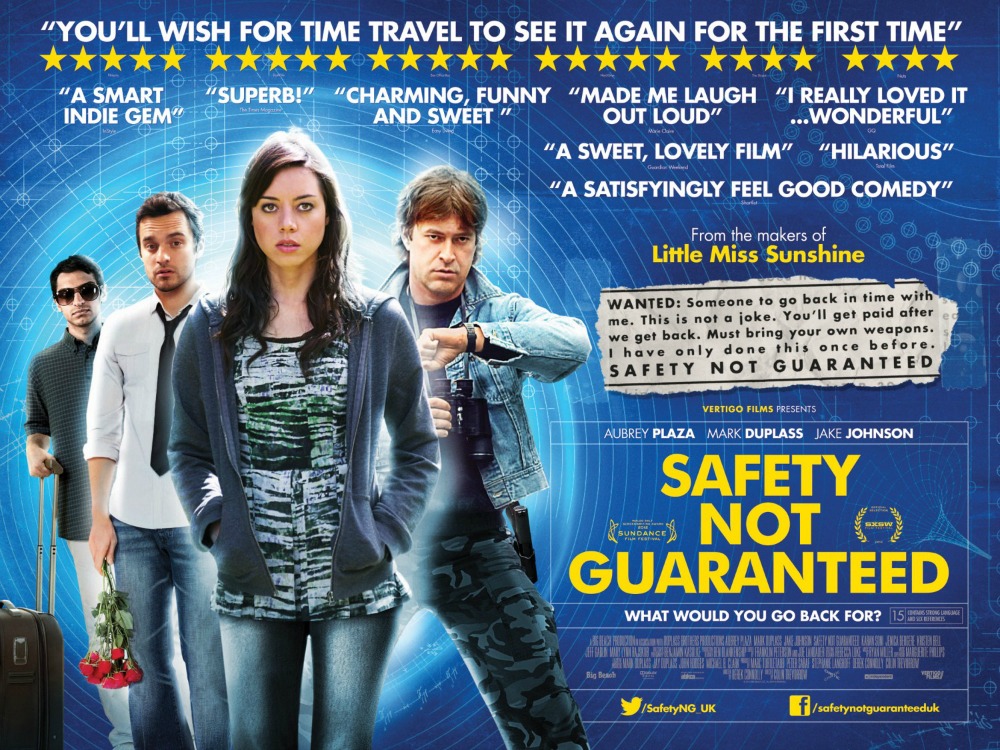
This was a film which I had to find when I read about it, a clever low-budget story that starts with an ad in a magazine looking for a companion for traveling through time. It proves to be a relatively enjoyable film about relationships, in which the plotline is mostly about whether or not the person who placed the ad is a nutcase, a liar with an agenda, or a genuine time traveler. That being the mystery not revealed until the end of the film, it was difficult to discuss the time travel elements without spoiling the end--but we managed to keep that answer for the last article of the short series, so you have time to watch it before you get to that part
-
Basics: sets up the story, introduces the characters, and begins raising the questions.
-
Before: considers the claim made by Kenneth Calloway that he did this "only once before", and what impact he might have had if that claim is true.
-
Changed: examines the problem that the girl Belinda St. Sing, whom he claims was killed, is apparently alive, and whether as he asserts that might demonstrate that he indeed has, in the future, already traveled to the past.
-
Unchanged: the opposite side of that problem is that Darius wants to save her mother's life, which does not appear to have happened, and so we have to consider how that fits with the claim that Kenneth has already saved Belinda's life.
-
Adventures: concludes the series with a look at what happens in the future, or the past, based on the revelations of the ending.
It is not necessary for a film to involve actual time travel to raise time travel issues. We have seen that with Terminator Salvation, and in other ways with movies like Next or Watchmen. Here the time travel issue begins with whether time travel happens in the story or not, and explores consequences of how that is answered.
That completes the index through 2013; next we will continue with articles published in 2014.











